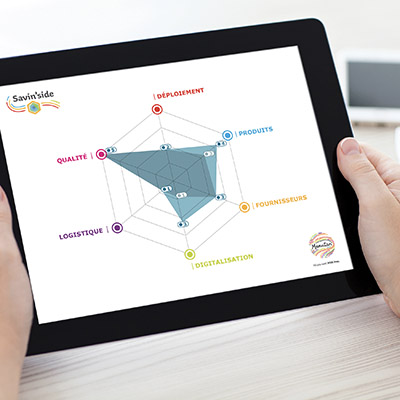Corporate social responsibility (CSR) enables companies to help protect the planet and its natural resources. In a world undergoing a transition to greener ways of operating, how can you reconcile economic growth with sustainable development for your company? Sustainable growth is the best way for you to incorporate environmental issues into your business strategy, making it greener.
What is sustainable growth?
As a new economic model for sustainable development, sustainable growth refers to all of a company’s business strategies and activities that enable it to meet its stakeholders’ needs while protecting natural and human resources. In other words, sustainable growth enables a company to thrive while reducing its negative impact on the environment and society.
Although it promotes economic development, green growth is also designed to reduce pollution, waste, wastage of energy resources, greenhouse gas emissions, etc. On a company level, it means an in-depth redesign and change of how it produces, consumes and accumulates.
As the international standard ISO 26000 states, the environment, the contribution to local development and working relations and conditions all fall within the remit of the company CSR policy. Sustainable growth is therefore the best way to support an effective CSR approach. But how can it be implemented in your own company?
How does your company switch to sustainable growth?
Every department in a company is affected by environmental issues. Management and general administration, human resources and procurement especially must work together to implement measures that foster people’s development and measures that protect the planet. When defining its sustainable growth strategy, the company should pursue multiple short- to medium-term objectives.
1. Preserving energy resources
After carrying out an audit, the company is able to adjust or even reduce its energy consumption (electricity, water and gas). This is all the more important in the current era of energy conservation, as companies must reduce their consumption of natural resources. There are simple and effective solutions that can be implemented in companies:
· Motion detectors to automatically turn lights on and off;
· Smart thermostats to control the temperature remotely;
· LEDs to replace traditional light bulbs;
· Infrared mixers to save water;
· A to A+++ rated appliances found on the market.
2. Reducing your environmental footprint
Another factor for sustainable growth is the reduction of the company’s carbon footprint. To move away from fossil fuels in the future, the use of renewable energies should be considered, such as solar or wind energy, hydroelectricity, biofuels, etc.
Another option is to encourage suppliers to optimise their deliveries, both in terms of vehicle loading and the route they take. The aim is to ensure that trucks do not travel half empty and make unnecessary detours between their point of departure and destination.
Finally, the company can raise staff awareness and suggest that they opt for public transport or modes of transport that emit little CO2 (carpooling, cycling, scooters, electric cars) to get to their place of work. Also, when employees work from home, it means they are reducing their commute, thereby reducing their environmental footprint.
3. Waste management
Sustainable consumption means buying better and consuming more reasonably, of course, but it also means better disposing of waste. Reuse, product donation and recycling help to extend products’ lifespans. These measures help implement the circular economy into the company.
There are lots of ways to improve waste management:
· Installing waste sorting bins;
· Repairing damaged equipment instead of buying new equipment;
· Hiring equipment used on an ad hoc basis;
· Donating products to charitable associations...
Sustainable growth is thus multifaceted and permeates the daily lives of employees.
What are the benefits of sustainable growth?
Companies that have adopted new sustainable processes have seen many benefits as well as a sustainable growth rate.
Firstly, sustainability helps companies comply with regulatory and legal requirements. In response to global climate concerns, many countries are providing a legal framework for
companies’ green transition. For example, the NFRD[1] from the Green Pact for Europe will soon be replaced by the CSRD[2]. Rolled out gradually from 1st January 2024, the CSRD aims to standardise professional sustainability reporting and improve the publication of ESG data[3].
Investors and banks also like to support organisations that have a sustainable growth approach. As they are sensitive to CSR approaches, these business partners factor in extra-financial parameters so that they make responsible investments. Using ESG criteria, they have the ability to analyse the social and environmental impacts of a company.
Moreover, advocating for social and environmental causes improves a company’s image and employer brand. Consumers are increasingly interested in brand commitments, and more and more of them are turning to responsible organisations. Also, a reputation as a sustainable company attracts talent, reduces turnover and increases employee efficiency.
Finally, sustainable growth makes the company’s operations more sustainable in the future. By reducing internal costs and promoting shorter supply chains, the company makes smart savings. These savings can then be reinvested in development or optimisation projects.
Sustainable growth: challenges ahead?
Despite the benefits, any company involved in a green growth project must also overcome certain obstacles. Regardless of the business sector, sustainability measures affect both production and employees. This means companies need to get them involved through training and awareness raising to ensure they stay committed.
There are also additional costs when implementing sustainable practices. The initial investment a company makes in sustainable procurement, optimisation and innovation, is a more substantial future. And the results are difficult to quantify, as the growth is only visible in the long term.
Finally, a lack of information, adequate tools, knowledge, and expertise can slow down the implementation of a sustainable growth policy. A sustainable business is usually only successful after thorough preparation and defining an appropriate strategy.
In order to combine economic growth and sustainable development, companies must rely on an ecosystem of innovative and reliable partners. Your suppliers can support you with integrating sustainable growth into your business from the initial vision to the implementation and management of your green transition project, no matter where you integrate it into your business model, including your company’s investment in capital, or its consumption and production of products and services.
[1] Non Financial Reporting Directive
[2] Corporate Sustainability Reporting Directive
[3] Environmental, social and governance risks








